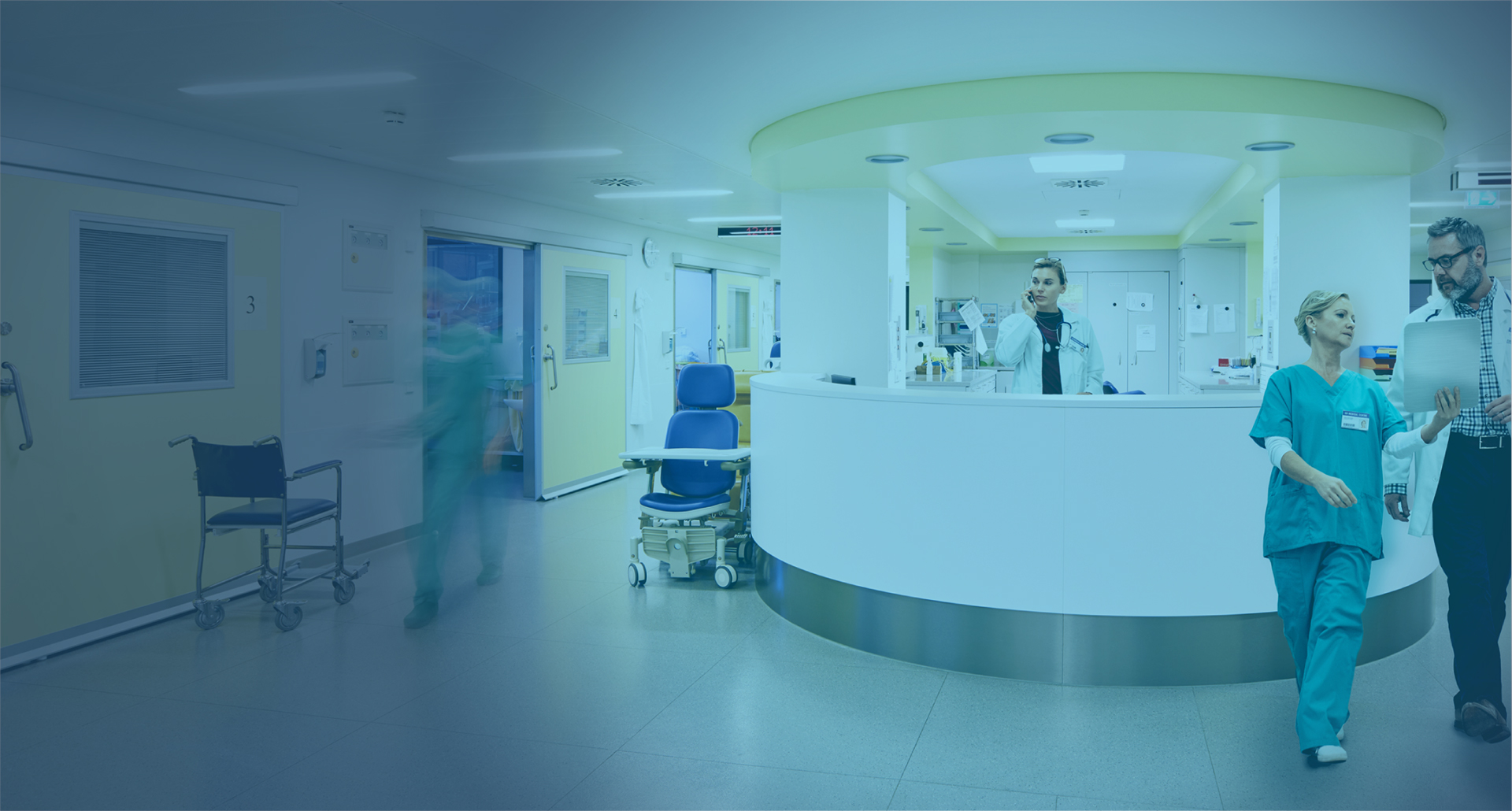
PATIENT INTAKE
An aging and growing population are driving the demand for hospital care. An efficient and seamless intake process is essential.1
TECHNOLOGY REALMS
PERSONALIZED MEDICINE
IOT + RPM
PRIVACY/SECURITY
WI-FI
DATA + INTELLIGENCE
Each year, patients spend millions of hours completing intake forms in waiting rooms.2 An EHR that follows a patient throughout his or her hospital journey would eliminate the need for repeated paperwork.
LIVE FEED
Data created by average hospitals (YTD)
2282
TB995
GB331
MBAverage: 11.55 MBps
DO NO HARM
HIPAA compliance, the standard requirements to protect sensitive patient data, is a top priority for any healthcare organization. Compliance requires login security, dedicated personnel, disaster recovery plans and ongoing security assessments to manage risks.5 Hospitals need to ensure they are prioritizing the protection of sensitive patient information.
PROVIDE THE FULL STORY
Electronic Health Records (EHR) follow a patient throughout his or her hospital stay, hosting patient history, recording test results and containing care plans.1
93%
Of physicians find value in having a mobile health app connected to Emergency Health.4
80
MINUTES
Average time saved in emergency rooms when non-critical patients use virtual clinicians and other digital services. 3
SOURCES
[1] Hewlett Packard Enterprise (2016), "healcare.nxt". Retrieved from https://h20195.www2.hpe.com/V2/GetDocument.aspx?docname=4AA6-7807ENW [2] Tech CEO Council (2006), "How Improved Information Management can Transform the Quality, Efficiency and Value of Americans' Health Care". Retrieved from http://www.techceocouncil.org/clientuploads/reports/A_Healthy_System_Final.pdf [3] The Wall Street Journal (March 27, 2017), "Can Tech Speed Up Emergency Room Care". Retrieved from https://www.wsj.com/articles/can-tech-speed-up-emergency-room-care-1490629118 [4] Referral MD, "30 Amazing Mobile Health Technology Statistics for Today's Physician". Retrieved from https://getreferralmd.com/2015/08/mobile-healthcare-technology-statistics/ [5] Protech Talen & Technology (August 28, 2018), "Maintaining HIPPA Compliance in your Technology Environment". Retrieved from http://www.psgi.net/news/posts/maintaining-hipaa-compliance-in-your-technology-environment

NURSING STATION
In order to quickly treat the patients requiring urgent care, nurses must be able to analyze and act on data from a myriad of sources.1
TECHNOLOGY REALMS
PERSONALIZED MEDICINE
IOT + RPM
PRIVACY/SECURITY
WI-FI
DATA + INTELLIGENCE
Percentage of healthcare spending that is wasted on inefficiencies throughout the hospital.2
LIVE FEED
Data created by average hospitals (YTD)
2282
TB995
GB331
MBAverage: 11.55 MBps
AN OUNCE OF PREVENTION
Since 2011, the number of health data breaches have increased 70%. With the threat of cyberattacks higher than ever, is your hospital taking preemptive steps to ensure the security of patient data?
STAYING SECURE
IoT devices help to track the safety of staff, patients and inventory.4
67%
Of healthcare enterprises are undertaking initiatives to transform their business operations and improve patient experiences.1 Is your hospital keeping up?
1TB
PER DAY
Daily increase in volumes of data at some hospitals. With device connectivity and the increasing complexity of health scans, this figure will increase.3 Flexible storage options grow with your hospital's needs.
SOURCES
[1] Hewlett Packard Enterprise (2016), "healcare.nxt". Retrieved from https://h20195.www2.hpe.com/V2/GetDocument.aspx?docname=4AA6-7807ENW [2] The World Health Report (2010), "Health Systems Financing". Retrieved from https://www.who.int/whr/2010/10_summary_en.pdf?ua=1 [3] Hewlett Packard Enterprise (November 2015), "Erasmus MC finds the remedy for its data storage headache". Retrieved from https://www.hpe.com/us/en/pdfViewer.html?resource=/content/hpe/country/us/en/resources/solutions/case-study/erasmus-medical&parentPage=/us/en/solutions/healthcare [4] IoT For All (May 3, 2018), "6 Exciting IoT Use Cases in Healthcare". Retrieved from https://www.iotforall.com/exciting-iot-use-cases-in-healthcare/ [5] Forbes (September 25, 2018), "Government Data Says Millions of Health Records Are Breached Every Year". Retrieved from https://www.forbes.com/sites/michelatindera/2018/09/25/government-data-says-millions-of-health-records-are-breached-every-year/#a04961a16e66

PATIENT EXAMINATION
With new devices continuously collecting and recording patients' vitals, connectivity is more important than ever.
TECHNOLOGY REALMS
PERSONALIZED MEDICINE
IOT + RPM
PRIVACY/SECURITY
WI-FI
DATA + INTELLIGENCE
of serious medical errors involve miscommunication during care transitions.1
LIVE FEED
Data created by average hospitals (YTD)
2282
TB995
GB331
MBAverage: 11.55 MBps
ENOUGH BANDWIDTH FOR EVERYTHING
With an average of 10-15 connected devices per bed, it's essential that hospitals have a strong, stable Wi-Fi to support the connectivity of life-saving devices.4
ALWAYS IN THE KNOW
Empowering patients enables hospital staff to become more agile. Information can be pushed to a patient's mobile device providing turn-by-turn directions throughout the hospital, keeping track of appointment times and sending medication alerts and reminders.
EVERY SECOND COUNTS
Collecting, organizing and acting on patient data is crucial for preventing unforeseen diseases and infections.
25%
Of patients report that their health records did not reach a new healthcare provider in time for an examination.3 Secure connections permit fast, reliable data transfers.
350
MBPS
Data upload speeds using HPE Online Import Technology.2
SOURCES
[1] Joint Commission (August 2012), "Joint Commission Center for Transforming Healthcare Releases Targeted Solutions Tool for Hand-Off Communications". Retrieved from https://www.jointcommission.org/assets/1/6/tst_hoc_persp_08_12.pdf [2] Hewlett Packard Enterprise (February 2016), "Changhua Christian Hospital Builds New Image System". Retrieved from https://www.hpe.com/us/en/pdfViewer.html?resource=/content/hpe/country/us/en/resources/solutions/case-study/changhua-hospital&parentPage=/us/en/solutions/healthcare [3] Referral MD, "30 Healthcare Statistics That Keep Hospital Executives Up At Night". Retrieved from https://getreferralmd.com/2016/08/30-healthcare-statistics-keep-hospital-executives-night/ [4] Healthcare IT News (February 29, 2016), "Cybersecurity pro: Networked medical devices pose huge risks to patient safety". Retrieved from https://www.healthcareitnews.com/news/cybersecurity-pro-networked-medical-devices-pose-huge-risks-patient-safety

POINT OF CARE
At the point of care, every second could be the difference between life and death. Reliable Wi-Fi and connectivity not only save time - they save lives.
TECHNOLOGY REALMS
PERSONALIZED MEDICINE
IOT + RPM
PRIVACY/SECURITY
WI-FI
DATA + INTELLIGENCE
Three out of every 10 tests and lab results cannot be located. They get lost in transit from one facility or hospital to another, and need to be reordered.
LIVE FEED
Data created by average hospitals (YTD)
2282
TB995
GB331
MBAverage: 11.55 MBps
SAVE TIME AND HEADACHES
Some health examinations require a patient to remain still for hours. A dropped connection can result in restarting the test.5 A fast, strong connection is essential to increase efficiency and improve the patient experience.
EVOLVING TOOLS
Robotic surgery grants clinicians more precision, flexibility and control, allowing for less invasive procedures. Ultimately, the patient feels less pain, recovers faster and experiences fewer complications.6
82%
REDUCTION
Reduction in patient exposure to radiation, as compared to outmoded scanning methods, provides a safer experience.3
1
SECOND
Time it takes to create a 3D image of a heart.3 Outdated scanners can take up to 20 minutes for a lesser quality scan.4 Faster, more detailed scans allow clinicians to act quickly and move the patient to the next treatment phase.
SOURCES
[1] Hewlett Packard Enterprise (May 1, 2017), "Healthcare Providers Improve Patient Care with HPE Data Storage". Retrieved from https://www.youtube.com/watch?time_continue=2&v=R93bfhBgfXY [2] Referral MD, "30 Healthcare Statistics That Keep Hospital Executives Up At Night". Retrieved from https://getreferralmd.com/2016/08/30-healthcare-statistics-keep-hospital-executives-night/ [3] Hewlett Packard Enterprise (2017), "3D cardiac imaging: no longer a dream". Retrieved from https://www.hpe.com/us/en/pdfViewer.html?resource=/content/hpe/country/us/en/resources/solutions/case-study/3D_cardiac_imaging&parentPage=/us/en/solutions/healthcare [4] Inside Radiology, "CT Coronary Angiography (CTCA)". Retrieved from https://www.insideradiology.com.au/ctca/ [6] Hewlett Packard Enterprise (May 1, 2017), "Healthcare Providers Improve Care with HPE Data Storage". Retrieved from https://www.youtube.com/watch?time_continue=2&v=R93bfhBgfXY [7] Mayo Clinic, "Robotic Surgery". Retrieved from https://www.mayoclinic.org/tests-procedures/robotic-surgery/about/pac-20394974

DISCHARGE
Following discharge, continued communication helps patients safely return home and prevents unplanned readmissions.1
TECHNOLOGY REALMS
PERSONALIZED MEDICINE
IOT + RPM
PRIVACY/SECURITY
WI-FI
DATA + INTELLIGENCE
is spent annually on unplanned hospital readmissions.2
LIVE FEED
Data created by average hospitals (YTD)
2282
TB995
GB331
MBAverage: 11.55 MBps
TAKE THE WHEEL
Access to their personalized discharge plans through their EHR helps patients avoid readmission and puts them firmly in the driver's seat on their journey to recovery.3
THE MODERN HOUSE CALL
Remote Patient Monitoring (RPM) allows clinicians to closely observe patients' vitals remotely, saving both parties time and output. 5
27%
PREVENTABLE
Of hospital readmissions are preventable.3 Repeated hospital stays are costly, increase the risk of infection and impede a hospital's ability to care for as many patients in need as possible.
10%
REDUCTION IN
READMISSIONS
Reduction in 30-day readmissions when clinicians use web apps to message newly discharged patients. 4 Digital communication allows clinicians to monitor their patients without exposing them to added risks.
SOURCES
[1] Referral MD, "30 Amazing Mobile Health Technology Statistics for Today's Physician". Retrieved from https://getreferralmd.com/2015/08/mobile-healthcare-technology-statistics/ [2] Protech Talen & Technology (August 28, 2018), "Maintaining HIPPA Compliance in your Technology Environment". Retrieved from http://www.psgi.net/news/posts/maintaining-hipaa-compliance-in-your-technology-environment [3] UpToDate (December 19, 2017), "Hospital discharge and readmission". Retrieved from https://www.uptodate.com/contents/hospital-discharge-and-readmission [4] Referral MD, "30 Healthcare Statistics That Keep Hospital Executives Up At Night". Retrieved from https://getreferralmd.com/2016/08/30-healthcare-statistics-keep-hospital-executives-night/ [5] Hewlett Packard Enterprise (2016), "healcare.nxt". Retrieved from https://h20195.www2.hpe.com/V2/GetDocument.aspx?docname=4AA6-7807ENW
FUTURE-PROOF FOR OPTIMAL PATIENT CARE
The Prescription for a Digitally Evolving World
The Challenge:
The healthcare space is inundated with complexity, and hospitals must evolve. By taking a digital healthcare posture, hospitals can drive a positive patient experience and streamline resources. Is your hospital prepared?
The Solution:
HPE is here to help your hospital keep pace with a digitally evolving world.
We offer solutions designed to keep critical patient information flowing, within reach of clinicians, and secure.
Take Action:
Position your hospital as a leader in technology-enhanced healthcare. HPE's full suite of solutions drive optimal patient care and clinical excellence across the hospital experience.
Start future-proofing your hospital today. Our team of experts is ready to support your hospital at every step of the journey.









